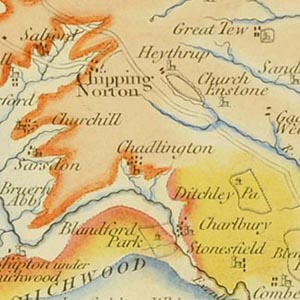 |
Village of Churchill as shown on Smith's 1815 Map
|
William Smith was born in the village of Churchill, Oxfordshire on 23 March 1769. His father, John Smith the local blacksmith, died when he was eight years old. Smith attended the village school until around 1780 but would later state that his education there was limited, spending the period after leaving school teaching himself the skills of geometry, drawing and calculations believed suitable for a career as an engineer or surveyor. This self-education paid off, as he became an assistant to the land surveyor Edward Webb of Stow on the Wold (who had been appointed to make a complete survey of the parish of Churchill) in 1787.
By 1793, Smith was employed to survey canal routes for the proposed Somerset Coal Canal. He spent the following year on a fact finding mission to discover the best in coal canal engineering around the country. During this trip Smith, accompanied by two local colliery owners Richard Perkins and Samborn Palmer, had seen the latest development in waterways’ engineering on the Shropshire Canal – a caisson. A caisson, or caisson lock, was designed to replace water wasting, multiple canal locks through the use of a watertight, wooden box (into which a canal boat manoeuvred) which would then descend down through a deep cistern of water which connected the higher and lower canals.
 |
| Branch of the Somerset Coal Canal with the ill-fated caisson near Combe Hay, from 'A Map of Five Miles round the City of Bath...' (1799). Source: Bath Central Library. |
Due to the likely water supply problems in the area, three caissons were proposed for the new canal, the first being constructed in 1797 under the supervision of its inventor Robert Weldon at Combe Hay, just south of Bath. Cracks in the structure appeared soon after, and when during a test run in 1799 a party of potential investors nearly suffocated, it was abandoned. Smith was dismissed.
Thereafter Smith began to lead a more peripatetic life, becoming a surveyor and engineer for hire.
|